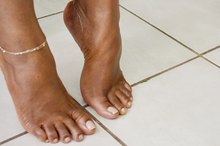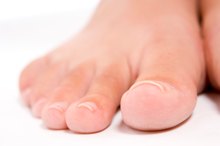Can Peroxide Treat Nail Fungus?
Nail fungus can be attributed to the growth of fungi within the nail bed. This can be the cause of exposure to warm, damp environments. Initially, the fungus may appear as a white or yellow spot on the nail and can develop into a more serious condition that causes the entire nail to thicken, discolor and even crack. This can cause pain and tenderness when touched or even when exposed to cold or heat.
Oxidative Therapy
The use of hydrogen peroxide to treat nail fungus, is also known as oxidative therapy 2. Treating nail fungus require that the toenail be soaked several times a day in a 3-percent peroxide solution. If the hydrogen peroxide exceeds 3 percent, it may cause skin irritation.
Hydrogen Peroxide and Vinegar
Vaseline Lip Therapy on a Cold Sore
Learn More
Another solution involving the use of hydrogen peroxide to treat nail fungus includes soaking it in a solution mixed with vinegar 2. The solution is mixed 50:50 hydrogen peroxide to vinegar, and you then soak the affected nail in the solution and allow it to dry thoroughly before covering.
Prevention
Nail fungus is contagious 12. When using a public venue, remember to keep feet and nails adequately covered. Keep nails short and clean and after washing feet thoroughly, be sure to dry completely. The use of anti-fungal sprays and powders in shoes can help kill any lingering bacteria, but allow shoes to dry thoroughly before wearing them again. This may mean that you will need two pairs available at all times. One to wear while the other air dries.
- Nail fungus is contagious 1.
- This may mean that you will need two pairs available at all times.
Warning
How to Kill Toenail Fungus With Bleach
Learn More
If you feel that you have any sort of nail fungus, it is best to consult your family healthcare practitioner. Getting treatment as soon as possible can help to keep the problem from becoming worse.
Related Articles
References
- Cure Nail Fungus: EarthClinic.com
- Using Hydrogen Peroxide to Treat Nail Fungus: CureNailFungus.com
- Shirwaikar AA, Thomas T, Shirwaikar A, Lobo R, Prabhu KS. Treatment of onychomycosis: an update. Indian J Pharm Sci. 2008;70(6):710-4. doi:10.4103/0250-474X.49088
- Syed TA, Qureshi ZA, Ali SM, Ahmad S, Ahmad SA. Treatment of toenail onychomycosis with 2% butenafine and 5% Melaleuca alternifolia (tea tree) oil in cream. Trop Med Int Health. 1999 Apr;4(4):284-7. doi:10.1046/j.1365-3156.1999.00396.x
- Buck DS, Nidorf DM, Addino JG. Comparison of two topical preparations for the treatment of onychomycosis: Melaleuca alternifolia (tea tree) oil and clotrimazole. J Fam Pract. 1994 Jun;38(6):601-5.
- Chee HY, Lee MH. Antifungal activity of clove essential oil and its volatile vapour against dermatophytic fungi. Mycobiology. 2007;35(4):241-3. doi:10.4489/MYCO.2007.35.4.241
- Gayoso CW, Lima EO, Oliveira VT, Pereira FO, Souza EL, Lima IO, Navarro DF. Sensitivity of fungi isolated from onychomycosis to Eugenia cariophyllata essential oil and eugenol. Fitoterapia. 2005 Mar;76(2):247-9. doi:10.1016/j.fitote.2004.12.005
- National Institutes of Health. "Fungal nail infection: MedlinePlus Medical Encyclopedia". June 2011.
Writer Bio
Pamela Harrison began writing in 2010. Her work has appeared in various online publications. Harrison's expertise is in health, fitness, parenting and relationships. She is currently writing her own novel, with hopes of having it published in the near future.









